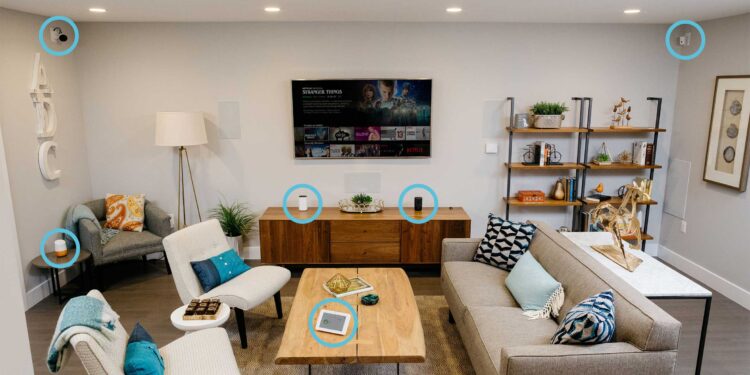The rapid advancement of technology has transformed our homes into smarter, more efficient spaces. Smart home automation often called the Internet of Things (IoT) for homes, has revolutionised our lives, offering convenience, security, and energy efficiency. From intelligent thermostats that optimise comfort to security cameras that keep a vigilant eye on our premises, a smart home ecosystem represents the future of residential living, where innovation and convenience merge to create a truly connected home experience.
This paradigm shift towards home automation has given rise to what can only be described as a “Smart Home Ecosystem” – a web of interconnected devices, systems, and technologies designed to enhance convenience, security, and energy efficiency within our homes. As we explore this complex world, we will uncover the various parts of the smart home ecosystem and see how they work together to change our daily lives.
Components of a Smart Home Ecosystem
-
Central Hub or Controller
A central hub or controller is at the heart of every smart home ecosystem. This command centre device lets you connect and manage all your smart devices from a single interface.
-
Smart Lighting
Smart lighting systems replace traditional light bulbs with connected LED bulbs or fixtures. They can be controlled remotely through a smartphone app, voice commands, or automated schedules. The ability to adjust brightness and colour temperature and create lighting scenes enhances convenience and helps reduce energy consumption.
-
Smart Thermostats
Smart thermostats provide precise control over your home’s heating and cooling systems. They learn your preferences and adjust the temperature accordingly, optimising energy usage. You can control them remotely and set schedules to maximise comfort and savings.
-
Smart Security Systems
Home security is a top priority for many homeowners. Smart security systems encompass a range of devices, including:
- Smart Cameras: These cameras offer real-time monitoring, motion detection, and cloud storage for video footage. They can provide a sense of security, whether at home or away.
- Smart Doorbells: Devices like the ‘Ring Video Doorbell’ allow you to see and communicate with visitors remotely. They also include motion detection and video recording features.
- Smart Locks: With smart locks, you can lock and unlock your doors remotely, grant access to guests, and receive notifications when someone enters or leaves your home.
-
Smart Home Appliances
Modern home appliances like refrigerators, ovens, washing machines, and coffee makers can be integrated into the smart home ecosystem. These appliances can be controlled remotely and may have features like scheduling, energy monitoring, and remote diagnostics.
-
Smart Speakers and Voice Assistants
Smart speakers are central hubs and provide entertainment and information through voice commands. They can control other smart devices in your home and answer questions, play music, and more.
-
Smart Sensors
Various sensors, such as motion detectors, door/window, and environmental sensors, contribute to your smart home’s overall functionality and automation. They trigger actions based on specific conditions, such as turning on lights when motion is detected or adjusting the thermostat when the temperature changes.
-
Smart Plugs and Outlets
These devices can transform ordinary appliances and devices into smart ones. You can remotely control power outlets, set schedules, and monitor energy usage, making them valuable additions to your home automation ecosystem.
-
Smart Window Treatments
Smart blinds and curtains allow you to control natural light and privacy with a button or through automation. They can integrate with other smart systems like lighting and thermostats to optimise energy efficiency.
-
Voice and App Control
Most smart home ecosystems offer voice control through popular voice assistants. Additionally, smartphone apps provide a user-friendly interface for controlling and monitoring your smart devices from anywhere.
Benefits of a Smart Home Ecosystem
From enhanced convenience to heightened security, a smart home ecosystem brings numerous advantages that cater to modern lifestyles. Let’s explore these benefits in detail:
- Convenience: Smart homes offer unparalleled convenience, allowing you to control and automate various aspects of your home easily.
- Energy Efficiency: Smart thermostats, lighting, and appliances help reduce energy consumption, leading to lower utility bills and a reduced carbon footprint.
- Security: Smart security systems provide real-time monitoring, enhancing homeowners’ safety and peace of mind.
- Customisation: You can tailor your smart home to your preferences, creating personalised automation routines and settings.
- Remote Access: Whether at work or on vacation, you can monitor and control your home remotely, ensuring everything is running smoothly.
The Power of Trusted Brands in Building Your Smart Home Ecosystem
The world of the smart home ecosystem is on an exciting trajectory, promising an even more connected and smarter future for our homes. Investing in components from reputed brands is a wise choice to maximise the benefits of this innovation and ensure a hassle-free experience. Not only does it enhance your lifestyle, but it also plays a crucial role in fostering a sustainable and eco-friendly living environment.
So, as you embark on your smart home journey, remember that the choices you make today can significantly impact the future of your home automation experience.






